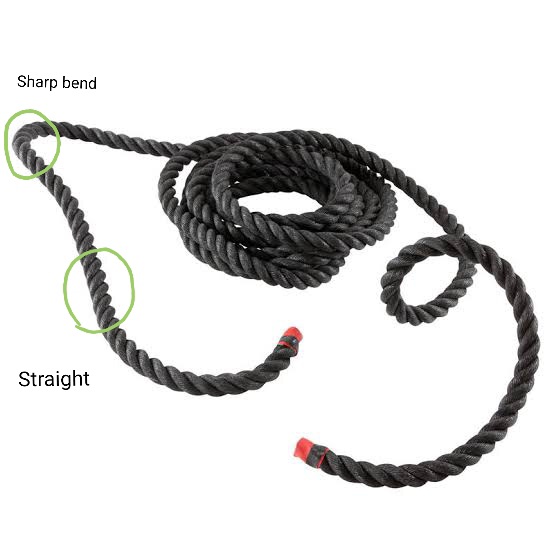What if we bend the rope sharply? Something like this
Thing is, I don't see anything/anyone actively bending the rope- i.e. applying an external bending force on the rope.
Generally speaking the outer fibers of the bend would be subject to tensile stress and the inner fibers compressive stress. But if there were any significant tensile or compressive stresses you would expect one of two things. Either there would be stress recovery happening, i.e., the rope would unbend itself. Or any significant stresses that did exist have cause permanent deformation of the fibers.
The only apparent external forces that could be maintaining the curvature of the rope would be friction between the rope and the table (for the circled curved section), or friction between adjacent sections of the rope in the center area.
In this case, if we consider the two sections of the rope, one that
has a sharp bend and the one that is fairly straight (shown in the
picture), is tension in those two sections the same?
Since there aren't any apparent external forces maintaining the bends, other than friction, if there are tensions in the rope they would likely be very slight, and the tension in the outer fibers of the circled curved section perhaps slightly more than the almost straight section.
The rope is still not accelerating, so according to Newton’s 2nd law,
tension in those two sections should be the same. But isn’t the part
of rope that is bent feeling more stress compared to the part where
the rope is fairly straight?
Rather than thinking in terms of the rope "accelerating", think in terms of whether or not the curvature of the bends would change were it not for the friction between the rope and the table. Where the curvature spontaneously changes, stresses existed.
How can I prove it mathematically that tension in those two sections
is not the same (if it's not)?
If we were dealing with a something made of materials that are homogeneous (uniform composition and uniform properties throughout) and isotropic (having physical properties that are the same when measured in different directions) it might be possible. But we are dealing here with natural or synthetic materials with a complex woven structure. I think rope manufacturers rely more on standardized testing to determine strength and fatigue rather than mathematical formulae.
Hope this helps.

